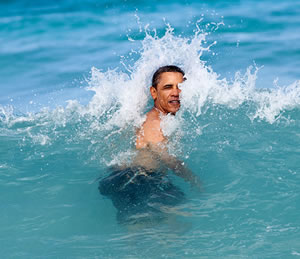
In a quiet affair without fanfare, President Barack Obama signed into law the $633 billion Fiscal Year 2013 National Defense Authorization Act (NDAA) on 31 December while vacationing in his home state of Hawaii. While not an appropriations act providing the funding to pay for the provisions contained in the law, the NDAA does outline the specific projects and programs the Department of Defense (DoD) is authorized to pursue. Actual funding authorization will be included in an appropriations bill yet to be finalized.
Although several articles in the NDAA did not sit well with Secretary of Defense Leon Panetta and President Obama, the White House did get most of what was requested with $1.7 billion additional funding included. Secretary Panetta publicly expressed his disappointment that funding added by Congress for some items were neither requested nor needed by DoD. Mr. Panetta had hoped to have those funds reprogrammed into other projects he considered of greater importance.
While expressing opposition to the provisions of the law that limit the president’s authority to transfer terrorist detainees from the Guantanamo Bay, Cuba prison to other facilities for another year, the president was quoted as saying his signing of the bill was necessary to ensure that defense funding was not delayed and to ensure critical defense needs were covered.
Although the FY 2013 NDAA does represent a modest cut in defense spending, the reductions are those agreed to by the White House and Congressional leaders in August 2011.
Aircraft manufacturers and shipbuilders are pleased with the FY 2013 NDAA. The Act broadens authorization for several multiyear procurement (MYP) projects. The Act gives the Pentagon an additional year on the MYP for the EA-18G Growler electronic warfare aircraft and the F/A-18E/F Super Hornet strike fighter. Also included in the measure is an MYP slated to begin in 2013 for the V-22 Osprey tiltrotor aircraft, a 2013 MYP for construction of as many as ten Arleigh Burke-class guided-missile destroyers, and a 2014 MYP to cover the cost of constructing as many as ten nuclear-powered Virginia-class fast attack submarines.
Another provision in the Act gives the US Navy approval to continue with the major overhaul and refueling of the Nimitz-class aircraft carrier USS Abraham Lincoln. Incremental funding is also authorized for the new Gerald R. Ford-class aircraft carrier and authority to spend a maximum of $708 million to cover the cost of deactivating the USS Enterprise.
The Act also derails the Navy’s plans to deactivate four Ticonderoga-class guided-missile cruisers (CGs) and two Dock Landing Ships (LSDs) by prohibiting the use of FY 2013 funds for this purpose. The Act also requires the Navy to maintain a minimum fleet of twelve ballistic-missile submarines (SSBNs) and provides no funding for deactivation of these submarines.
Also included in the Act are provisions that clearly reflect Congressional intent to play a more active oversight role in determining future defense structure and capabilities. Language contained in the law requires the Navy to provide Congress with periodic reports detailing progress being made in the development of the Littoral Combat Ship (LCS) program to include specifics related to ship design, operational support, planned sustainment, and mission capabilities.
Congress also recommended that the Department of the Navy conduct an evaluation of the viability of its amphibious warfare fleet. The Act advises the Navy to review its plans for future investment in the development and procurement of a new generation of large amphibious assault ships. The Congress suggests the Navy give careful consideration to hull commonality issues and combat survivability concerns.
Wording in the Act further prohibits the Navy from naming a single prime contractor for the Unmanned Carrier-Launched Surveillance and Strike System (UCLASS) until a thorough Preliminary Design Review (PDR) is completed. The Navy is also required to deliver to Congress a progress report on development of the Shallow-Water Combat Submersible (SWCS) program.
Much to the Navy’s displeasure, the Act also requires the service to designate specific Initial Operational Capability (IOC) dates for both the F-35B and the F-35C Joint Strike Fighters (JSF) no later than June 2013. The Pentagon has been very reluctant to establish specific IOC dates for the JSF as the aircraft has been plagued with technical delays, production difficulties, and widely-publicized cost increases throughout the life of the program.
Marine Corps electronic warfare capabilities also drew the attention of Congress resulting in a requirement that Congress be given a detailed report addressing the planned disposition of the Corps’ EA-6B Growler electronic-warfare squadrons.
Included in the Act are also provisions designed to slow down development of a new East Coast missile-defense system. This new missile-defense shield, a favorite of many Republican lawmakers, is likely to be a hot topic in negotiations to craft an FY 2014 NDAA beginning this spring.
The NDAA also imposes new sanctions on Iran that are expected to have an impact on Iran’s energy and shipping industries, shipbuilding capabilities, and seaport services. Broadcasting services and trade in precious metals were also singled out for sanctions.
Although restrictions on the export of satellites and associated equipment were relaxed, restrictions on some nations will continue in effect. The measure continues restrictions prohibiting satellite exports for any launches originating in China, Iran, North Korea, Syria, Sudan, and Cuba.
Officials in Beijing have expressed their displeasure with the US refusal to export satellites to China in light of previous indications that the United States was sincere in improving relations with Beijing and had previously intimated that American exports of high-tech equipment to China for civilian use could be expected to increase.
















